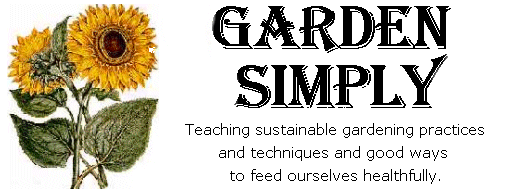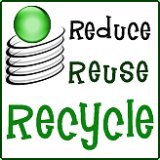
|
|
Home Starting Seeds IndoorsEveryone knows my love of organic and sustainable gardening, but fewer know my desire to save and grow my own seeds. But for years and years, no matter where I've lived or what the circumstance, my fingers get itchy if I can't get them in the dirt by the end of January. I buy new stuff, I use old stuff... I don't care how it looks. In fact, most often, it's my bedroom that turns into a miniature greenhouse for a couple of months, always giving me a headstart on spring. It keeps me on top of what is going on in the garden from beginning to end. Here's a lot of my process. It's not a fool proof formula, but it's the ritual I go through every winter.... 1. Getting the Seeds PlantedI use 2-deep plastic flats with water holes in the bottom and fill them with a dry soilless growing mix, firming it down until it is 1/2 from the top of the flat. Sow seeds in furrows three times as deep as the seed's diameter. If seeds need light to germinate, cover them very lightly if at all. Space small seeds 1/8, medium seeds 1/2 and large seeds an inch apart. Space rows 1-1/2 to 2 inches apart to allow seedlings room to grow their first true leaves before transplanting. Label each row with the name of the plant and variety, and the date of sowing. 2. Flats.... Moist and Warm Depending on what you're growing of course! But if they can stand much cold, you'd be better off starting them in a cold frame or a hotbed outside and saving your precious space for plants that will not tolerate the cold (or even cool) I set planted flats in a waterproof tray filled with 1/2- to 3/4-inch of water. Because the watering is done from the bottom of the flat, seeds don't get washed out or disturbed. The trays also provide a water reservoir that can help keep your growing medium moist but not soggy. Tepid (65° to 70° F) water is best. Never allow the soil to dry out completely. To maintain humidity during germination, I place the flat in a plastic bag, cover it with plastic food wrap or some other lightweight something. Don't seal it all completely tight, that encourages mold. The air needs to circulate. Seed flats need bottom heat of 75° to 85° F. I place my flats on top of the fluorescent light fixtures, but you could also put them on top of a refrigerator or near another heat source, such as a wood stove or radiator. Or use one of the bottom heat mats made for this purpose. 3. Light Source Once seeds germinate, they need light. Adjust the height of the fluorescent lights so they are nearly touching the sprouted seedlings, and I use a timer to turn the lights on for 16 hours and off for eight hours each day. (This is when it gets hairy in my bedroom. I tend to work into the wee hours of the night...) Most seedlings need less heat than germinating seeds. Most seedlings will grow best at temperatures of 60° to 70° F during the day and night temperatures that are 10 degrees cooler. 4. (and my favorite part...)Transplant Seedlings When seedlings produce their first set of true leaves, it's time to transplant them into larger containers. Transplanting gives plants room to grow and improves air circulation. It also stimulates the growth of the bushier feeder roots. Fill the transplanting flat (or other larger container) with moistened growing medium. I recommend you use the same soilless mix used for germinating the seeds. Firm the mix to within 1/2 inch of the top of the container. I use six 2 x 2 inch plastic six-pack pots in each waterproof tray. I make a planting hole for each seedling with my finger, then use a wooden popsicle stick to lift seedlings. (It gives me a good reason to buy popcicles, what CAN I say?) I hold each individual plant by its leaves rather than by the stem, using the stake to lift the roots as I gently pull the plant up. Keep the rootball intact when setting the plant in its new spot. Most plants can be set slightly deeper than they were growing in the germination flat. Firm the soil over and around the newly set plant so that the soil and roots are in close contact and there are no air pockets. Set the transplants back under the lights unless they wilt or droop. Droopers go in a shady, cool spot for a day until they perk up. 5. Grow to SizeCheck your transplants every day by feeling the soil surface. It should be moist but not soggy. Watering from the bottom directs the water to the root zone and prevents puddling on the soil surface, which could lead to damping-off. It's also less messy. I give the plants a drink of room temperature water every three or four days; more often as they get bigger. Plants without enough light will be weak and get leggy. As with the seedlings, I use four fluorescent lights above each flat and tape reflective mylar to the front and back sides of the fixtures to maximize the light directed to the plants. As these transplants grow, I increase the distance between the top of the plants and the bulbs to about 2 inches so that the light can spread more evenly over the flats. I grow transplants at the same temperatures that the seedlings were grown: 60° to 70° F during the day, with temperatures 10 degrees lower at night. One little trick if they start growing too fast for your transplanting schedule... Slow them down... Fast-growing plants will slow down if you lower the temperature while keeping light levels high. (ya gotta love fluorescent lights! Transplants do best when the relative humidity is between 50 and 70 percent. Maintain their humidity by misting them with a sprayer, setting the flats on top of trays filled with pebbles and water (an OLD trick) or covering your light setup with a plastic tent. Give transplants a little exercise to toughen them up by having a fan lightly blow on them. A fan can also help prevent green algae or mold from forming on top of the soil surface.Give transplants a constant, lean diet every time you water them. Use one-quarter the recommended amount of fertilizer per gallon of water. 6. Hardening Off (Definition) Before making the transition to the big bad garden, transplants need to toughen up. (you wouldn't go and run the Boston Marathon after only walking around the block once a day for a week now would you?)One week before you begin hardening your plants outdoors, cut back the amount of water you give them, stop their fertilizer and keep temperatures slightly cooler. Harden transplants gradually. Start by putting them outside on a day when temperatures are above 50° F. Leave them out for just half a day (or less) in a sheltered spot protected from strong winds. Be sure to keep the plants watered, as they dry out more quickly outside. Over the course of a week, extend the amount of time your transplants spend outside and increase their exposure to sunlight, wind and a range of temperatures. At the end of the week, your plants should be ready to go into the ground. A cloudy, warm, windless day is best for easing the plants' transition into their new homes. And there you have it. Save the seeds from your best plants and do it all over again next year! Sustainable gardening at it's finest! |
| Reading Room | Trees and Shrubs | Flowers | Composting | Soil | Nursery |
| Shopping | Books | Tools | News | Practical Advice | Internet Gardening | Links |
| Vermicomposting | Pest Management | How To's | Children | Overweight Kids |
| Home | Newsletter | About Us | Support | Contact |
|
GardenSimply.com | All Rights Reserved 2005 |

Garden Journal !!Join "Garden Notes" and plan for Harvest Success as you track and record your gardening progress. Your Free Personal Garden Journal includes printable pages making it easy for you to:
|
|
|
|
|
|
|
|
|
|

|
|
|
|
